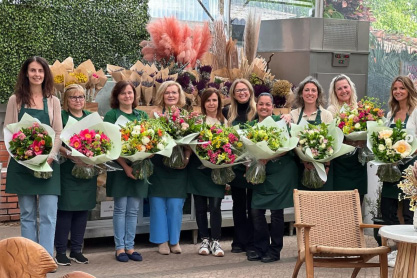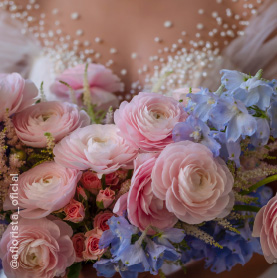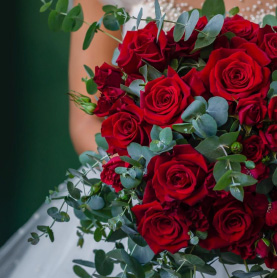Providing the best solutions for our clients requires a motivated team that enjoys sharing experiences, that is open to being inspired by the many different ways that life provides us and that is open to receiving the teachings of others. That’s why, at Horto do Campo Grande, we are committed to the continuous training of our employees, and we invited Tatiana Vieira, founder of the EAF – Escola de Arte Floral de Lisboa, to share her valuable experiences with our florists, shop managers and interior designers. We believe that this training in floral art, where everyone had the opportunity to explore new techniques and trends, represents added value for their own creations.
During this training we had the opportunity to interview her and invite her to share with us what she is most passionate about in floral art.


Tatiana comes from a completely different professional field than floral art. What made you fall in love with this area?
In order to unwind from the corporate environment, which I was part of for 25 years as an executive, I started studying floral art. Since then, it has become a recurring practice in which I invest a lot of discipline and time.
What are your sources of inspiration and how do you keep up to date?
In this field there are several top-quality professional artists and I try to attend classes with them in various parts of the world. Frequent contact with them is an asset when it comes to sharing ideas, inspiration and knowledge. The secret is to never stop studying and to have a learner’s heart. I believe that curiosity in acquiring new knowledge should be constant.
You teach floral art. Would you like to tell us what the current trends are? Which flowers and colours stand out the most?
The trend is characterised by good taste and sense in choosing quality flowers and different varieties. The purchase should not be guided solely by price, creativity and quality are priority factors, and repetition of flowers should be avoided.
How can you create a beautiful, up-to-date floral arrangement on a small budget?
Seasonal flowers and regional producers help a lot with the final cost. In Portugal we have producers who grow some of the best flowers in the world, and we have to look closely at these domestic productions.
Flowers are increasingly present in the decoration of our homes, particularly when we receive guests. How should floral arrangements be combined with tableware?
It should be in line with the initial briefing, where you realise what the occasion will be and for how many people, the location, and what the decoration of the room that will receive the arrangements will be, so that everything is in complete harmony.
Your origins are influenced by different geographies. How do these different cultures influence your preferences?
My origins provided a multicultural upbringing, I grew up in an environment where everything was experienced. There’s no doubt that my creativity and curiosity to learn came from my family environment.
Which flowers do you choose for each season?
It’s a difficult question to answer. When it comes to natural flowers, I love them all, but my favourites are the colourful freesias.
What tips and tricks can you give us to help our arrangements retain their beauty for longer?
The secret begins with the purchase, by choosing good producers and quality flowers, followed by the most important care. Sanitising the vases, cutting the flowers, cleaning the stems and changing the water daily are some of the precautions we should take when the flowers come from a good source, but it requires discipline and daily care.


May is known as the month of brides.
What do brides look for most, both for decorating their wedding venue and for their bouquet?
There are different types of brides, but the more natural, loose, deconstructed styles are the most sought after, reminiscent of natural gardens where flowers bloom naturally and this visual design enchants everyone.
What should a florist’s main concerns be in order to fulfil expectations for such a special day?
From my point of view there are several aspects to take into consideration: planning, aligning the expectations of the bride and groom, a contract that covers all the details, a well-designed budget, ordering everything well in advance and having a plan B for possible unforeseen events, such as the weather.



© Companhia das Cores for Horto do Campo Grande

